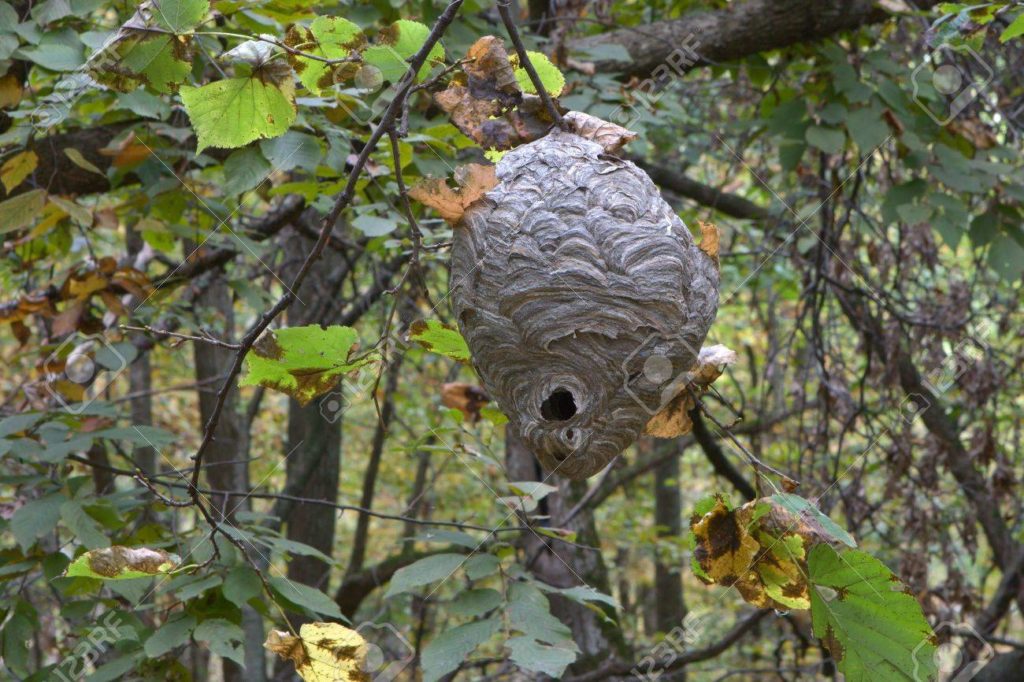
Wasps often set up their nests in trees around homes and office buildings. While this may seem preferable to them building a nest right on the building itself, it can still be quite problematic. They’re a nuisance and a threat, especially to those who are allergic.
They can be off-putting to guests or visitors (or customers in the case of a business), and make it a risk every time you go anywhere near that tree or around your property. Some people may be tempted to get a long stick or a garden hose and try to use that to knock the nest down.
That’s absolutely the worst thing you can do, and almost always will end up with you getting stung, repeatedly, by hundreds if not thousands of wasps.
If you are worried about a wasp nest in a tree, remember that height is, first and foremost, a consideration. Nests below around 10 feet or so are considered hazardous.
Higher than that, and the wasps are far less likely to feel threatened by any human presence on the ground. In either case, if you want a wasp nest removed, it’s best left to professional exterminators, who have the equipment and skills to safely and effectively remove the wasps and the nest, without anyone getting hurt.
Paper Wasps
Paper wasp nests get their name because they look like they are made of thin, delicate layers of paper. In fact, though, these are a fibrous, plant-based material that the wasps create, by chewing on plants and mixing them with their saliva, to form a natural building material that’s quite durable.
These nests seem very fragile, but are well-made, weather-resistant, and generally water proof. This is especially true of those nests and species that are setup in trees, as opposed to under a roof overhang or somewhere else that is out of the way of any inclement weather.
Many people also mistakenly believe that it’s safe to handle wasp nests yourself during the winter, because the wasps die off. While the workers and males do die off, the queens generally hibernate and survive.
There’s no guarantee a nest is totally vacant, and that your activities won’t provoke a response, even in winter. So it’s best to leave the removal of wasp nests in trees to the professionals.
Removing Wasp Nests from Trees
As mentioned above, it’s best to leave wasp nest removal from trees to the professionals. For a start, anything you do on a ladder or bucket truck is dangerous, and that’s not even considering the actual wasps and nest itself. Additionally, if you are allergic, or unsure if you are allergic, you should never intentionally threaten a wasp or wasp nest – you’re just asking for a trip to the hospital.
With that said, a lot of people do try to take wasp nest removal into their own hands. While we do not recommend this, if you absolutely must try it yourself, then you need to wear protective clothing, have effective and safe insecticides, and follow the manufacturer’s directions.
The best time of day for these activities is at night or in the early morning, as wasps tend not to be very active when it’s dark. Don’t use a ladder or lift, especially if you are not trained or comfortable on one. And always let someone know what you are doing, in case you are stung and have an allergic reaction, so that they can get help.
Really, the best choice, however, is to leave all of that work to the pros. That’s what exterminators are here for! We have a full team of licensed and trained exterminators who can remove wasp nests from trees or anywhere else on your property.
In addition, they can handle any kind of home pest infestation, and help you prevent a recurrence. For your own safety and peace of mind, leave wasp nest removal to the experts!

Recent Comments